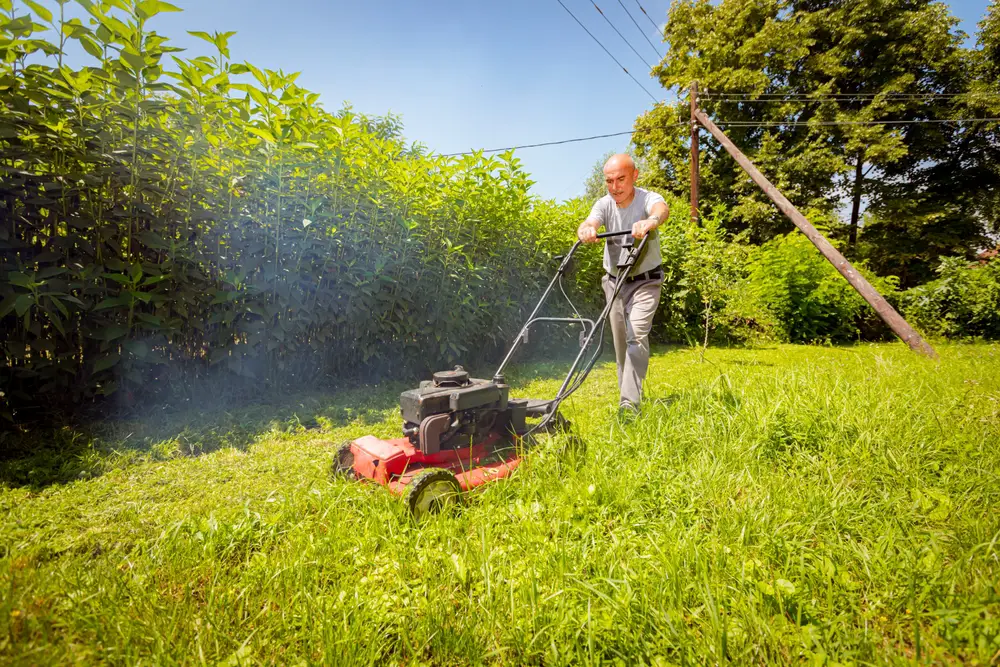In this content you’ll learn:
Key Takeaways
- Your lawn mower is smoking for various reasons.
- The top ten reasons include:
- Overfilling the oil
- A dirty or clogged air filter
- Spark plug issues
- Old or contaminated fuel
- Blocked exhaust or muffler
- Worn piston rings or cylinders
- Your engine overheating
- Using the incorrect oil
- Carburetor issues
- An incorrectly tilted lawn mower
- Some issues require a quick fix, while others need professional assistance.
Issues happen with lawn mowers, even with the best preventative maintenance. One issue is your lawn mower smoking, but just what causes this issue?
Top Ten Reasons Your Lawn Mower Is Smoking (And What To Do For Each)
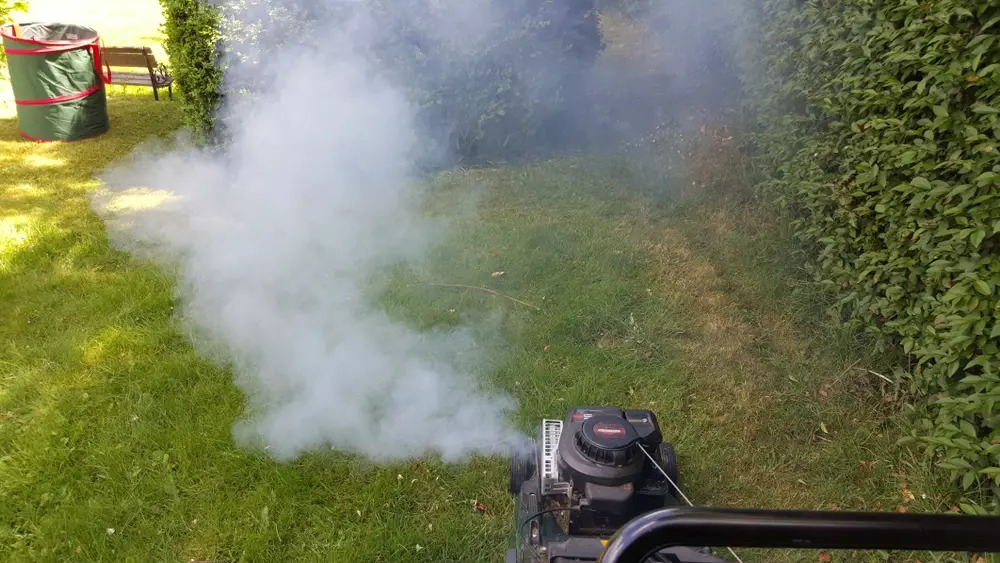
There are many reasons why your lawn mower is smoking. The many components of a lawn mower could fail at any time, and smoking is a sure sign your lawn mower needs your immediate attention.
To help, here are the most common reasons your lawn mower is smoking.
To begin, we’ll start with some safety precautions you should take.
Follow Proper Safety Precautions
Staying safe is the first step when performing any lawn mower maintenance.
Gather the following items:
Keep these on at all times, and pay attention to your lawn mower. If you notice anything unusual or dangerous, consider contacting a professional.
Lastly, always work in a well-ventilated space and keep your lawn mower on level ground. Chock the wheels too so it won’t roll.
1 – Oil Overfill Or Spillage
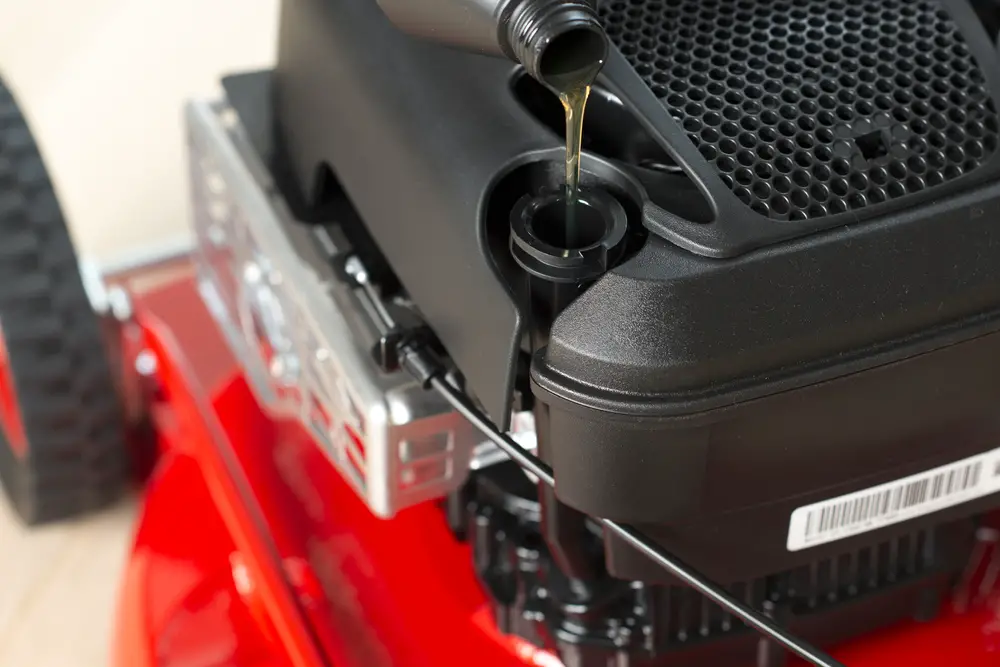
You’ll notice smoke coming from your lawn mower’s exhaust if you overfill your lawn mower’s oil reservoir. The oil pressure may cause gaskets throughout the inner part of the engine to rupture if you add too much oil. If gaskets rupture from the pressure, the oil will spew out and land on the engine components causing smoke.
When oil spills onto your lawn mower’s motor or other components, the engine heats it, creating blue or white smoke. This can cause a fire, although it’s unlikely.
What To Do
Check the oil level to see if it is over the full mark.
Locate the oil cap with “OIL” written on the top or an oil can design. Unscrew the cap, use an old rag to wipe off the oil, and put the dipstick back in the tank.
When you pull the dipstick out again, look for the add, safe, and full markings. You will need to drain the excess oil if it exceeds the full mark.
Slowly remove the cap under the oil tank to release some oil into a drain pan. Replace the cap and recheck the oil level. Repeat this process until you get a reading below full.
Wipe off any oil on the engine. Your lawn mower may continue to produce smoke while running, but it will stop once any leftover oil burns off. Your main goal is to not let oil spill onto the ground or under the engine, as this can cause a fire.
2 – Dirty Or Clogged Air Filter
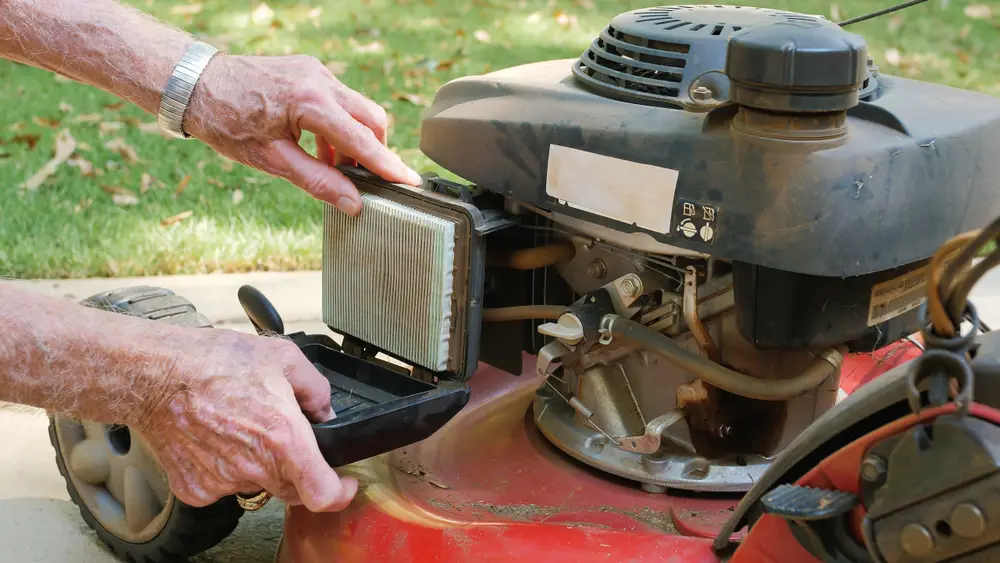
A dirty or clogged air filter could choke out the motor by not allowing the proper airflow and oxygen throughout the engine and its components. This strains the engine, producing dark grey or black smoke and losing horsepower.
What To Do
Check your owner’s manual to determine where your air filter compartment is. A wing-shaped nut holds it in place. Unscrew the nut, and you’ll find the air filter underneath the cover.
Replace the dirty or clogged air filter. You can clean it with an air compressor for light messes, or when replacing them is not an option.
Replace the filter, put the cover back on, screw the nut back, and run your lawn mower to see if it continues to smoke.
3 – Spark Plug Issues
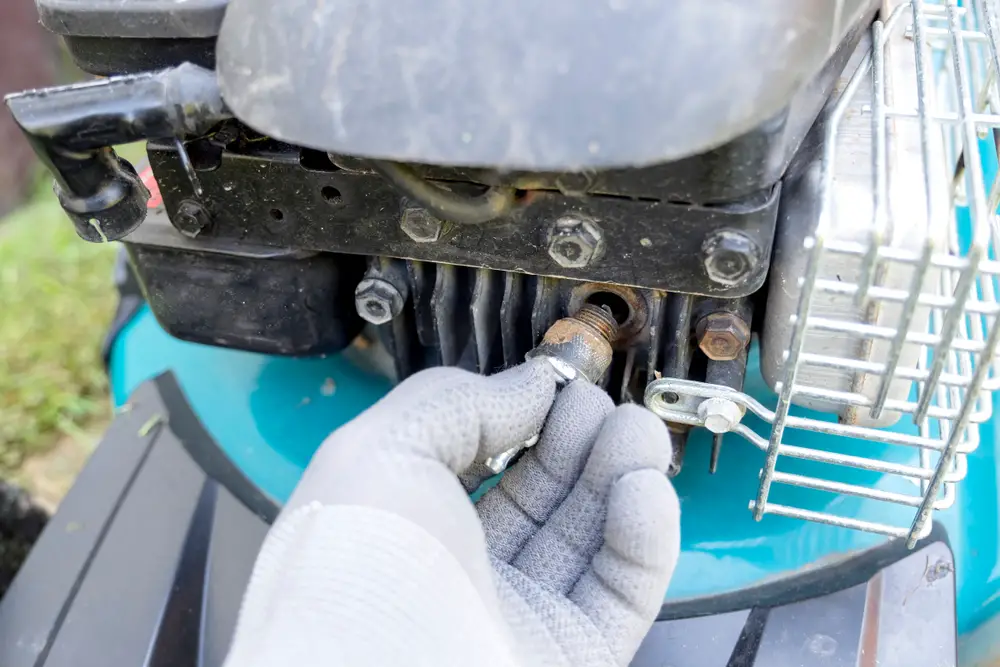
A faulty spark plug will cause misfiring and puffs of smoke. It will also cause your lawn mower to be hard to start and to idle roughly.
What To Do
You will find the spark plug at the front of the engine, where a single wire connects to a long white stem.
Remove the wire and take a ⅝” deep socket and ratchet set to remove the spark plug. You can clean the spark plug, but replacing it with a new one is better.
To determine if the spark plug requires replacing, use a gap tester and place it between the L-shaped ending and the point below. Check your owner’s manual recommendations on the gap measurements. If the gap is wider than the reading on the gap tester, it’s time for a new spark plug.
Put the new spark plug straight in the hole area without cross-threading it (this occurs when the spark plug is not straightforward in the hole). Start turning it to the right by hand, then tighten it snugly with the socket and ratchet set. Press the wire back on the end of the stem until it clicks into place.
4 – Old Or Contaminated Fuel
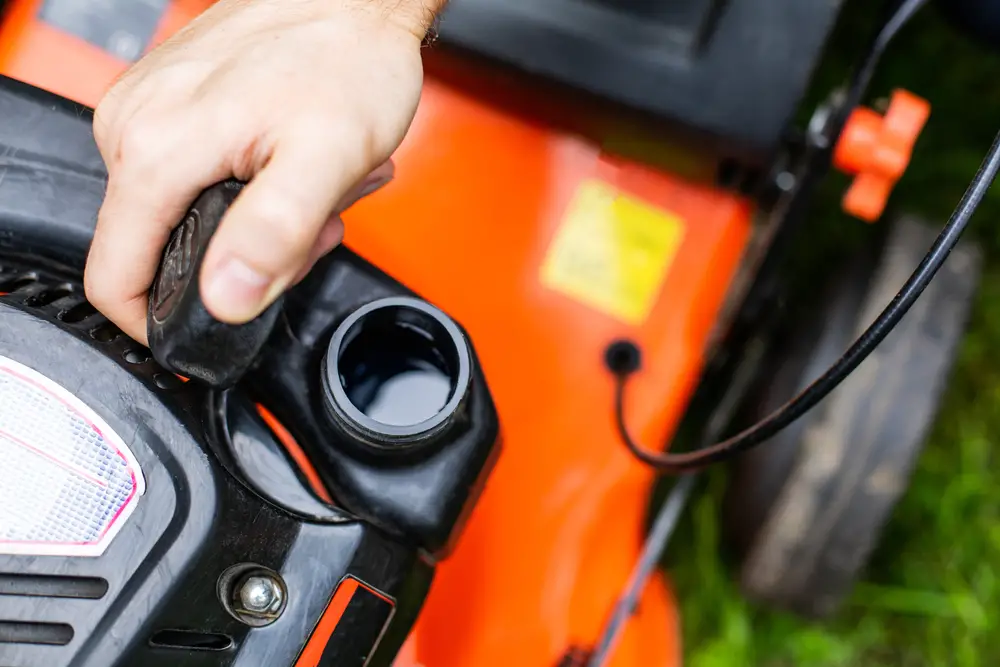
Old or contaminated fuel will cause a lawn mower to smoke, stall out, and make starting it difficult. It will also rough idle and lose horsepower.
What To Do
Replace the old or contaminated fuel with new fuel if the bad fuel has been in the tank for a week or less.
To remove fuel, use a siphon hose and container. Put one end of the hose in the fuel tank straight to the bottom. Place the other end of the hose in the container. Press the rubber ball until the fuel flows from the tank into the container.
Follow the Environmental Protection Agency’s (EPA’s) guidelines to discard bad fuel properly.
We strongly recommend using fuel treatment at completion and adding fresh fuel. This will clear out all the old fuel deposits or remnants. All fuel treatments have different instructions, so follow the instructions on the back of the bottle for application.
Contact a professional if the problem lingers.
5 – Blocked Exhaust Or Muffler
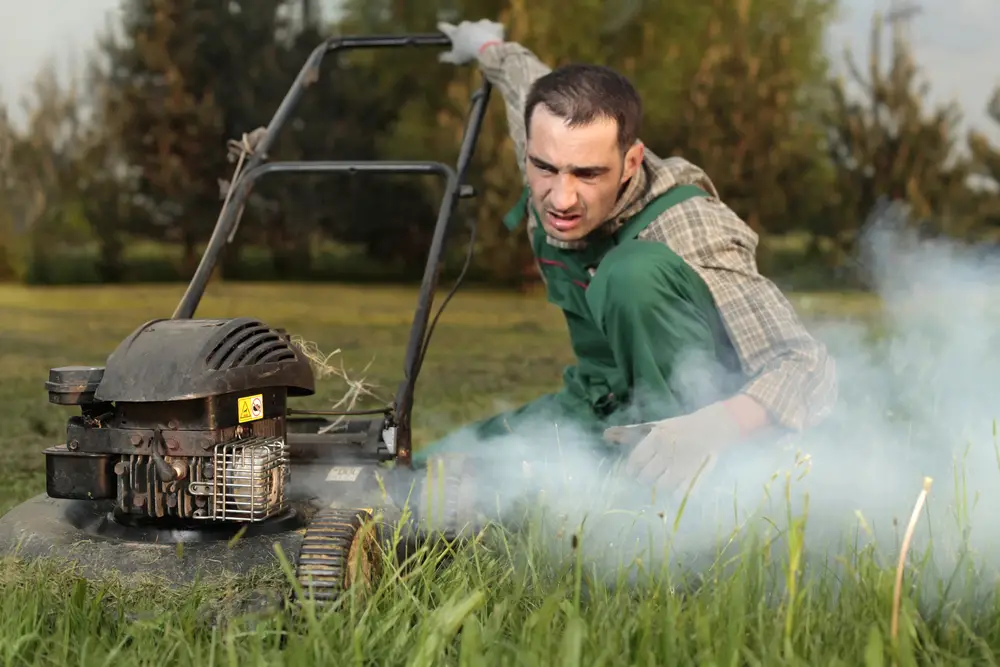
A blocked or clogged exhaust or muffler causes your lawn mower to choke up and smoke, like a clogged air filter.
What To Do
Find the exhaust and muffler on the lawn mower by looking it up in your owner’s manual. Inspect the exhaust area and remove any debris. You may need to replace the exhaust if fragments build up inside and stop the exhaust airflow.
Please know most muffler maintenance requires professional assistance. Cleaning helps but won’t get everything and is only a temporary fix.
6 – Worn Piston Rings Or Cylinders
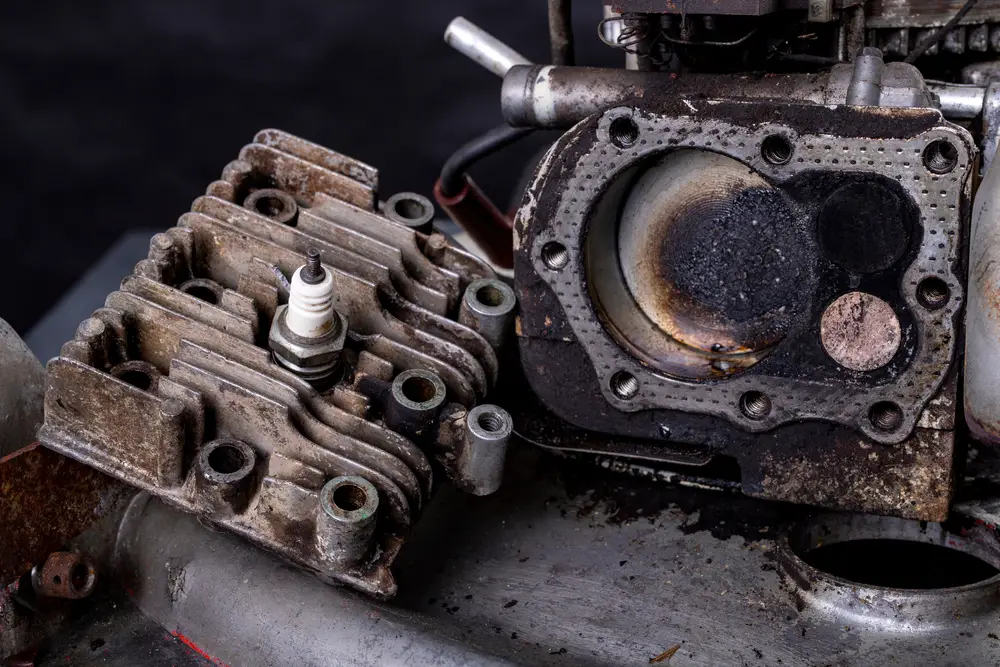
This is one of the worst-case scenarios. Worn piston rings or cylinders cause bluish smoke, a massive loss in horsepower, and excessive oil consumption. All of these components are inside the engine chambers.
What To Do
You can find piston rings and cylinders inside the engine chambers, but you’re best off leaving this issue to professionals. The maintenance will require taking the engine apart and rebuilding it.
Purchase a new engine (or lawn mower) if the repair cost exceeds the motor’s value.
7 – Engine Overheating
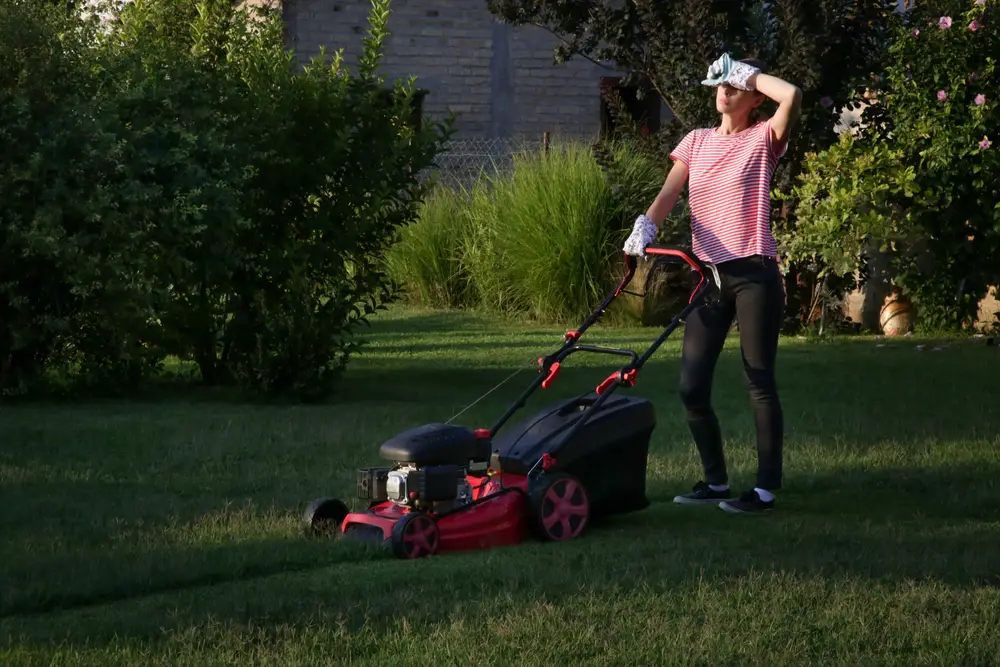
The most common reason for an engine overheating is an excess buildup of dirt and debris around the air vents. All openings around the hood of the lawn mower or the sides of the engine should be open and free from any obstructions.
You will see smoke and smell burning if your engine is overheating. Your engine will also put out excess heat, which you can feel from a short distance away.
What To Do
Turn the lawn mower off and let it cool down. Check your engine’s oil level after it’s cool. Add oil if it’s low.
Also, use a handheld blower or air compressor (the best option) to remove any engine blockages.
8 – Incorrect Oil Type
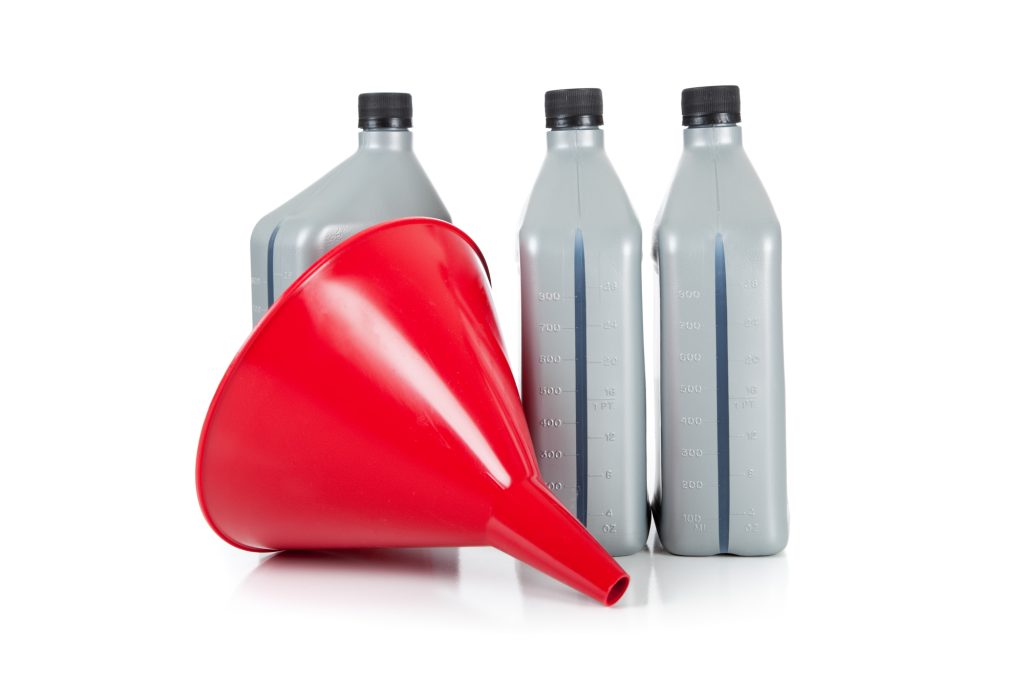
Oil lubricates the metal parts of your lawn mower. Many move fast and generate heat, so the parts will wear down much quicker if the oil isn’t right or provides improper lubrication.
Incorrect oil can also cause overheating, which can cause smoking. You’ll also notice a loss of horsepower in this instance.
The incorrect oil type may cause overheating and smoking to occur, in addition to a loss of horsepower.
What To Do
Check your owner’s manual for the correct oil. Most lawn mowers take 10W-30, but not all do.
Replace the wrong oil with the correct one if necessary (the process for which was mentioned previously in the section for old or contaminated fuel).
9 – Carburetor Issues
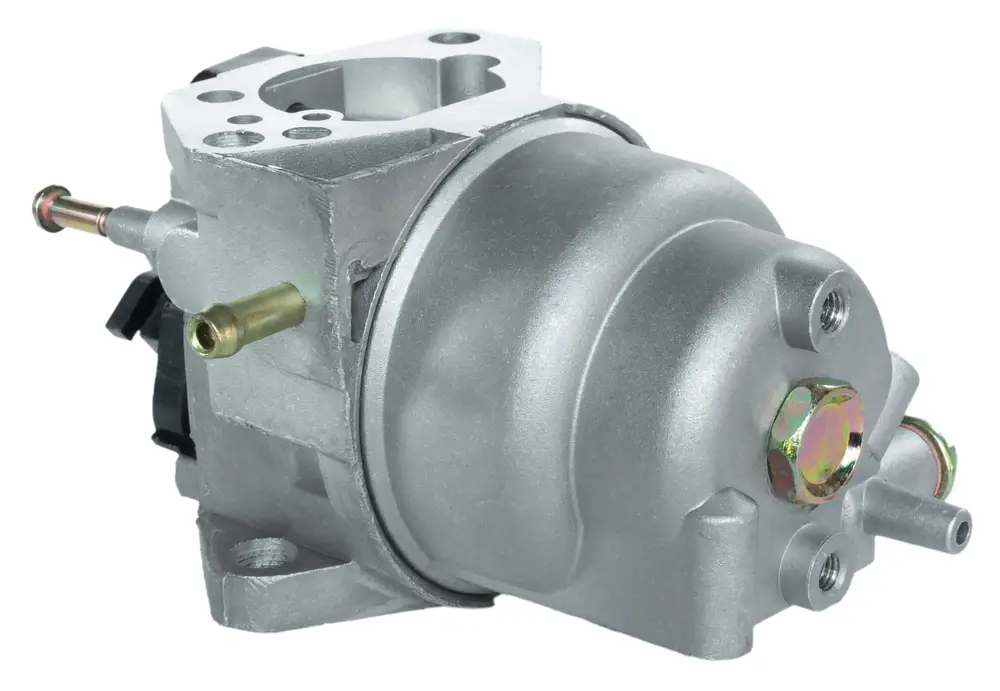
A clogged air filter can send debris to the carburetor, which would cause the lawn mower to smoke profusely.
What To Do
Remove the air filter cover and the compartment to get to the carburetor, which is right below this. Check the air filter while you do this. Excess debris means some probably got inside your carburetor, too.
Spray your carburetor with carburetor cleaner while the engine is off. Remember, it will be hard to start your lawn mower until the cleaner evaporates.
Notice how the lawn mower is running and if the smoke stops after a few minutes. This may be all it needs in repairs. However, try the throttle if the smoke continues with a loss of horsepower.
The throttle is the only metal bar on the side of the carburetor with a cable attached to it. Moving the throttle while your lawn mower runs should speed up the engine.
Contact a professional if the motor continues to stall and smoke. They will have to disassemble and clean the carburetor or replace it if this doesn’t work.
10 – Lawn Mower Tilted Incorrectly

If your lawn mower tilts on an incline of 15 degrees or more, the oil will spill over into areas it shouldn’t. It can get into the chambers or spill out of the oil tank if the cap is not on tight. If the oil hits a hot engine spot, it will smoke until it is burned off.
What To Do
Return your lawn mower to an upright, level position if this issue happens. Wait a day or so before starting it again in a well-ventilated area. Clean any spilled oil you see.
The smoking should stop once the oil burns off. Contact a professional if it persists.
5 Tips To Prevent Your Lawn Mower From Smoking
Here are some ways to prevent your lawn mower from smoking:
- Stay on top of your maintenance schedules, especially the oil changes every 50 hours.
- Get in the habit of regularly checking your lawn mower before, during, and after each cutting session.
- Always store your lawn mower on level ground, which helps you get an accurate oil level reading.
- Always keep a fire extinguisher nearby if oil spills onto the engine in case it catches fire.
- Double-check all fuel and fluid caps to ensure they’re tight before starting the engine.
My Experience With A Lawn Mower Smoking
Growing up, a neighbor would always chase away the families in the nearby houses because no one could breathe around all the smoke from his lawn mower. It made me wonder how he was so used to it.
One day, he brought his lawn mower to the shop to see if I could repair it. It turned out trash had built up in the carburetor over the years and was choking out the system. Cleaning the carburetor and changing the air filter made the lawn mower run like new.
When I asked him why he didn’t bring it to the shop sooner, he said he was afraid of how much damage there was, and he didn’t have the money for a new lawn mower or costly repairs. The cost of a new air filter and a little labor for the cleaning was well below $100.
One in five lawn mowers I fixed had this problem over the last decade. In half of these cases, the owners were afraid to bring their lawn mowers in due to their fear of the cost.
I advise never to assume or be afraid; just send it in for repairs if you are in doubt. Some mechanics will work with you on cost.
